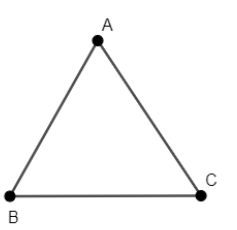
In an acute-angled triangle ABC, if $\sin \left( A+B-C \right)=\dfrac{1}{2}$ and $\cos \left( B+C-A \right)=\dfrac{1}{\sqrt{2}}$, then find the measure of each angle of the triangle.
Answer
592.2k+ views
Hint: Find the acute angle solution of the equations $\sin x=\dfrac{1}{2}$ and $\cos x=\dfrac{1}{\sqrt{2}}$. Write equations based on the data given in the question. Solve those equations to calculate the measure of all the angles.
Complete step-by-step answer:
We know that in an acute-angled triangle ABC, we have $\sin \left( A+B-C \right)=\dfrac{1}{2}$ and $\cos \left( B+C-A \right)=\dfrac{1}{\sqrt{2}}$. We have to calculate the measure of each angle of the triangle.

We will first calculate the acute angle solution of the equations $\sin x=\dfrac{1}{2}$ and $\cos x=\dfrac{1}{\sqrt{2}}$.
We know that $\sin {{30}^{\circ }}=\dfrac{1}{2}$ and $\cos {{45}^{\circ }}=\dfrac{1}{\sqrt{2}}$. We also know that $\sin \left( A+B-C \right)=\dfrac{1}{2}$ and $\cos \left( B+C-A \right)=\dfrac{1}{\sqrt{2}}$.
Thus, we have $A+B-C={{30}^{\circ }}.....\left( 1 \right)$ and $B+C-A={{45}^{\circ }}.....\left( 2 \right)$.
We also know that the sum of all angles of a triangle is ${{180}^{\circ }}$. Thus, we have $A+B+C={{180}^{\circ }}.....\left( 3 \right)$.
We will now simplify all the equations.
Subtracting equation (1) from equation (3), we have $\left( A+B+C \right)-\left( A+B-C \right)={{180}^{\circ }}-{{30}^{\circ }}$.
Thus, we have $2C={{150}^{\circ }}$. Rearranging the terms of the previous equation, we have $C=\dfrac{{{150}^{\circ }}}{2}={{75}^{\circ }}.....\left( 4 \right)$.
Substituting equation (4) in equation (2), we have $B+{{75}^{\circ }}-A={{45}^{\circ }}$. Rearranging the terms of the above equation, we have $B-A={{45}^{\circ }}-{{75}^{\circ }}=-{{30}^{\circ }}.....\left( 5 \right)$.
Similarly, substituting equation (4) in equation (3), we have ${{75}^{\circ }}+B+A={{180}^{\circ }}$. Rearranging the terms of the above equation, we have $A+B={{180}^{\circ }}-{{75}^{\circ }}={{105}^{\circ }}.....\left( 6 \right)$.
We will now simplify equations (5) and (5). Adding equation (5) and (6), we have $B-A+\left( A+B \right)={{105}^{\circ }}-{{30}^{\circ }}$. Thus, we have $2B={{75}^{\circ }}\Rightarrow B=\dfrac{{{75}^{\circ }}}{2}={{37.5}^{\circ }}$.
Substituting $B={{37.5}^{\circ }}$ in equation (6), we have $A+{{37.5}^{\circ }}={{105}^{\circ }}$. Thus, we have $A={{105}^{\circ }}-{{37.5}^{\circ }}={{67.5}^{\circ }}$.
Hence, the measure of all the angles of the triangle is $\angle A={{67.5}^{\circ }},\angle B={{37.5}^{\circ }},\angle C={{75}^{\circ }}$.
Note: We can’t solve this question without using the fact that the sum of all interior angles of a triangle is ${{180}^{\circ }}$. If we don’t use this fact, we will get an incorrect measure of the angles of the triangle. We must write the measures of all the angles in degrees or radians.
Complete step-by-step answer:
We know that in an acute-angled triangle ABC, we have $\sin \left( A+B-C \right)=\dfrac{1}{2}$ and $\cos \left( B+C-A \right)=\dfrac{1}{\sqrt{2}}$. We have to calculate the measure of each angle of the triangle.

We will first calculate the acute angle solution of the equations $\sin x=\dfrac{1}{2}$ and $\cos x=\dfrac{1}{\sqrt{2}}$.
We know that $\sin {{30}^{\circ }}=\dfrac{1}{2}$ and $\cos {{45}^{\circ }}=\dfrac{1}{\sqrt{2}}$. We also know that $\sin \left( A+B-C \right)=\dfrac{1}{2}$ and $\cos \left( B+C-A \right)=\dfrac{1}{\sqrt{2}}$.
Thus, we have $A+B-C={{30}^{\circ }}.....\left( 1 \right)$ and $B+C-A={{45}^{\circ }}.....\left( 2 \right)$.
We also know that the sum of all angles of a triangle is ${{180}^{\circ }}$. Thus, we have $A+B+C={{180}^{\circ }}.....\left( 3 \right)$.
We will now simplify all the equations.
Subtracting equation (1) from equation (3), we have $\left( A+B+C \right)-\left( A+B-C \right)={{180}^{\circ }}-{{30}^{\circ }}$.
Thus, we have $2C={{150}^{\circ }}$. Rearranging the terms of the previous equation, we have $C=\dfrac{{{150}^{\circ }}}{2}={{75}^{\circ }}.....\left( 4 \right)$.
Substituting equation (4) in equation (2), we have $B+{{75}^{\circ }}-A={{45}^{\circ }}$. Rearranging the terms of the above equation, we have $B-A={{45}^{\circ }}-{{75}^{\circ }}=-{{30}^{\circ }}.....\left( 5 \right)$.
Similarly, substituting equation (4) in equation (3), we have ${{75}^{\circ }}+B+A={{180}^{\circ }}$. Rearranging the terms of the above equation, we have $A+B={{180}^{\circ }}-{{75}^{\circ }}={{105}^{\circ }}.....\left( 6 \right)$.
We will now simplify equations (5) and (5). Adding equation (5) and (6), we have $B-A+\left( A+B \right)={{105}^{\circ }}-{{30}^{\circ }}$. Thus, we have $2B={{75}^{\circ }}\Rightarrow B=\dfrac{{{75}^{\circ }}}{2}={{37.5}^{\circ }}$.
Substituting $B={{37.5}^{\circ }}$ in equation (6), we have $A+{{37.5}^{\circ }}={{105}^{\circ }}$. Thus, we have $A={{105}^{\circ }}-{{37.5}^{\circ }}={{67.5}^{\circ }}$.
Hence, the measure of all the angles of the triangle is $\angle A={{67.5}^{\circ }},\angle B={{37.5}^{\circ }},\angle C={{75}^{\circ }}$.
Note: We can’t solve this question without using the fact that the sum of all interior angles of a triangle is ${{180}^{\circ }}$. If we don’t use this fact, we will get an incorrect measure of the angles of the triangle. We must write the measures of all the angles in degrees or radians.
Recently Updated Pages
Master Class 11 Economics: Engaging Questions & Answers for Success

Master Class 11 English: Engaging Questions & Answers for Success

Master Class 11 Social Science: Engaging Questions & Answers for Success

Master Class 11 Biology: Engaging Questions & Answers for Success

Class 11 Question and Answer - Your Ultimate Solutions Guide

Master Class 11 Business Studies: Engaging Questions & Answers for Success

Trending doubts
What is meant by exothermic and endothermic reactions class 11 chemistry CBSE

What are Quantum numbers Explain the quantum number class 11 chemistry CBSE

What is periodicity class 11 chemistry CBSE

Explain zero factorial class 11 maths CBSE

What is a periderm How does periderm formation take class 11 biology CBSE

Mention the basic forces in nature class 11 physics CBSE




